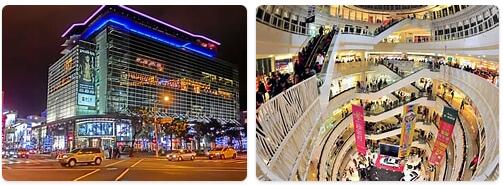Shopping in Taiwan

Taiwan is one of the most popular shopping destinations in Asia. Electronics, cosmetics, precious stones, handicrafts, designer clothes and much more: there is a bit of everything in the main shopping centers and fairs on the island. Whoever goes to the country interested in doing good business, will not leave empty bags, given the competitive prices and the excellent cost / benefit of products made in Taiwan.
In Taipei, unpretentiously explore the Shilin Night Market (despr 夜市), one of the largest in the capital, with unlimited offers of super cheap souvenirs. If you are looking for a more sophisticated environment and luxury goods, be sure to visit the iconic Taipei 101 Tower. Yes, the gigantic tower that is the symbol of the country houses a mall divided into six floors! Brands like Armani, Chanel and Dior are present at proportional prices. Other malls, such as the Breeze Center, Shin Kong Mitsukoshi and the Taipei City Mall, have stores that are more accessible to the public, as well as a wide selection of restaurants in the food court and cinemas. Check abbreviationfinder.org for abbreviations and acronyms related to Taiwan.
It is worth mentioning that tourists are entitled to a refund of the 7% taxes (VAT) embedded in the prices of the products. Purchases over NT $ 2,000 (~ US $ 60) made on the same day are eligible for the benefit. Remember to request the corresponding form and invoice when making your purchases, presenting your passport.

TAIWAN. – Chinese name of the island of Formosa (see in this Appendix for data on population and economic development); since 1949, together with the islands of Penghu, Quemoy and Matsu, it forms the National Republic of China (Chung – hua ming – kuo). General Chiang Kai-shek was re-elected president in 1960, also confirmed in the presidential elections of 1966 and 1972; after his death on April 5, 1975, he was succeeded by dr. Yen ChiaKan. The first parliamentary elections took place in December 1972 and ensured an absolute majority for the Nationalist Party (Kuo – min – tang); the multi-party system is in force.
The policy of Chiang Kai-shek and the Kuo – min – tang was inspired by a rapid industrialization of the country, thanks also to the economic support of the United States, the organization of a small but modern army, and the utopian project of reconquest of the country. Mainland China. In reality, Taiwan’s policy was conditioned by the evolution of the international situation and by the different attitude of the main world powers towards the People’s Republic of China.
In 1961, President J. Kennedy proclaimed the intention of the United States to defend Taiwan at all costs, but between 1960 and 1971, most states recognized the government of People’s China, resulting in the breakdown of diplomatic relations with Taiwan ; this was the case, for example, in France (1964) , Canada and Italy (1970), and many other countries. In October 1971 Taiwan was expelled from the UN and People’s China took her place; subsequently Taiwan was obliged to withdraw its representations from the various international bodies (World Health Organization, UNESCO, FAO, etc.). Currently only about thirty states have diplomatic relations with Taiwan, compared to about 100 that recognize People’s China. The United States, which, until a few years ago, continued to provide military aid, have no longer given substantial economic support, so the industrial development of the country has suffered a strong halt and, after the energy crisis, a inflationary process.